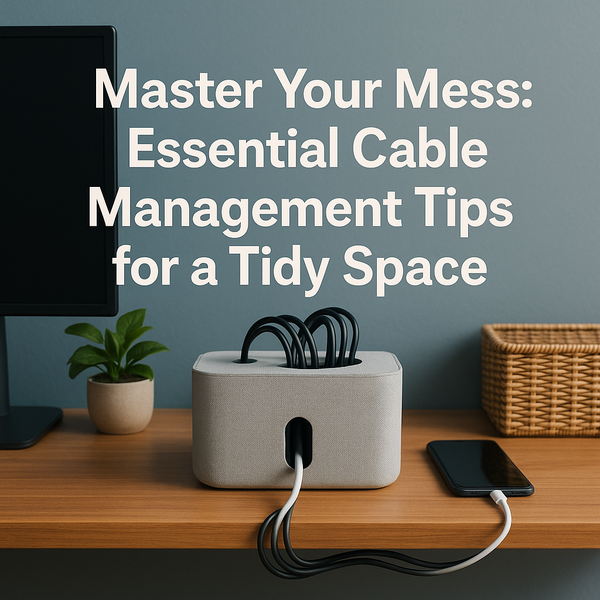
Tired of the tangled spaghetti monster lurking behind your desk or entertainment center? Effective cable management is crucial for both aesthetics and functionality. It not only makes your space look cleaner but also prevents damage to your cords and improves airflow. Let's dive into practical, easy-to-implement cable management tips that will transform your cluttered areas into organized havens.
Declutter and Categorize Your Cables
Before you can effectively manage your cables, the first crucial step is to declutter and understand what you're working with. Take some time to unplug all unnecessary devices and then systematically go through each cable. Identify which cables are essential and which ones are obsolete. You'd be surprised how many old charging cables or unused HDMI cords are still taking up space. Once you've identified the keepers, group them by type – power cords, USB cables, audio cables, etc. This categorization will make the subsequent management steps much smoother and more efficient. Consider using a label maker or simple tags to identify each cable's purpose, especially for those that look similar. This preliminary sorting not only clears out the unnecessary but also provides a clear overview of what needs to be organized, making the entire process less daunting and more manageable. Furthermore, as you declutter, check the condition of your cables; discard any that are frayed or damaged to prevent potential hazards.
Embrace Cable Sleeves and Ties
Once your cables are organized and you know which ones you're keeping, it's time to put them into order. Cable sleeves are fantastic for bundling multiple cords together into a single, neat unit. They come in various materials, from flexible fabric to more rigid plastic, and are excellent for hiding bundles of wires running across a desk or along a wall. For smaller bundles or individual cables, cable ties are indispensable. While traditional zip ties work, reusable Velcro ties are a more flexible and eco-friendly option, allowing you to easily add or remove cables as needed. When using sleeves or ties, avoid overtightening, as this can damage the internal wires of the cables. Aim for a snug but not restrictive fit. This approach not only tidies up the appearance but also reduces the risk of cables getting snagged or pulled, which can lead to damage or disconnections. Consider different colored sleeves or ties to color-code different types of cables, further enhancing organization and making it easier to identify specific cords when you need them.
Utilize Cable Raceways and Clips
For a more permanent and polished look, cable raceways and clips are excellent solutions. Raceways are essentially channels that adhere to walls, desks, or baseboards, allowing you to conceal cables completely within them. This creates a clean, seamless appearance, especially for routing cables from the wall to your devices. They can be painted to match your décor, making them virtually invisible. Cable clips, on the other hand, are smaller, adhesive-backed holders that attach to surfaces and guide individual cables. They're perfect for keeping frequently used cables, like phone chargers or USB cables, within easy reach and preventing them from falling behind your desk. When installing raceways or clips, ensure the surface is clean and dry for optimal adhesion. Plan your cable routes carefully before installation to minimize cutting and adjustments. This method offers a professional finish, significantly improving the overall tidiness and safety of your workspace or entertainment area. Remember to choose raceways that are large enough to accommodate the number of cables you intend to run through them.
Smart Power Strip Management
The power strip is often the epicenter of cable chaos. Managing this hub effectively is key to overall tidiness. Consider using a power strip with built-in surge protection and ample outlet spacing to accommodate bulky adapters without blocking adjacent outlets. For ultimate concealment, invest in a cable management box or a power strip cover. These boxes are designed to house the power strip and its excess cords, providing a clean exterior while allowing the plugged-in cables to exit neatly. Some boxes even have ventilation to prevent overheating. Alternatively, a power strip with a long, integrated cord can be strategically placed out of sight. Mounting your power strip under a desk or behind furniture can also drastically reduce visible clutter. When choosing a power strip, ensure it has sufficient amperage for your devices and consider smart power strips that allow you to control individual outlets remotely or on a schedule, adding a layer of convenience and energy efficiency to your setup. Always ensure your power strip is in good working condition and is not overloaded.
Creative Solutions and Future-Proofing
Beyond the standard tools, a little creativity can go a long way in cable management. Consider repurposing items like binder clips to hold cables in place on the edge of a desk, or using a pegboard with hooks to hang coiled cables. For a more integrated approach, look for desks or furniture with built-in cable management features like grommets and channels. When setting up new devices or reorganizing your space, think about future needs. It's easier to run an extra cable now than to have to dismantle everything later. Consider investing in longer cables if your current ones are constantly stretched taut. Wireless charging pads can also reduce the number of cables cluttering your surfaces. Even simple habits, like unplugging and neatly coiling cables when not in use, can make a significant difference over time. The goal is not just to hide cables, but to create a system that is both functional and aesthetically pleasing, making it easier to maintain your tidy space in the long run. Regularly review your setup to ensure it remains efficient and organized as your technology evolves.

